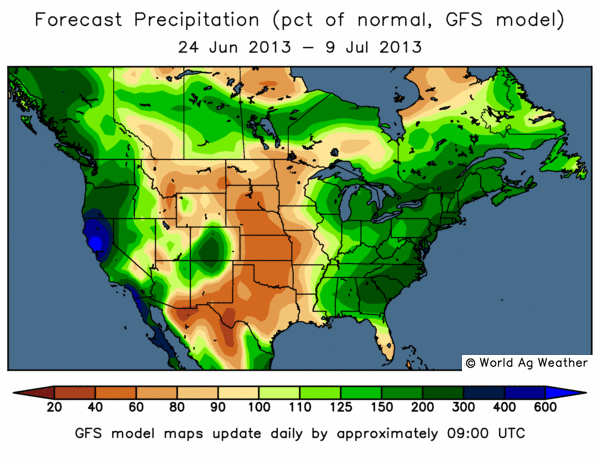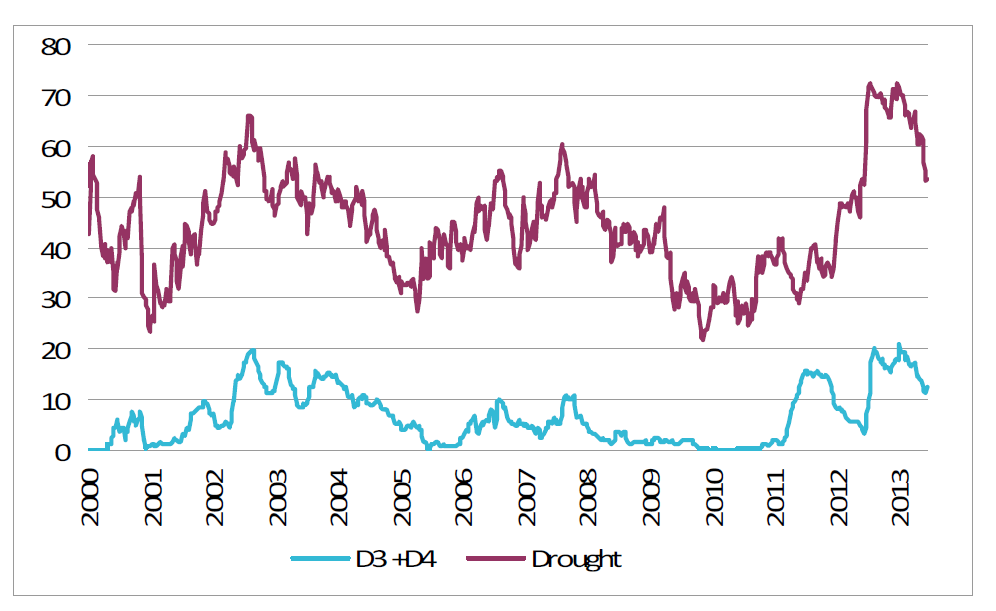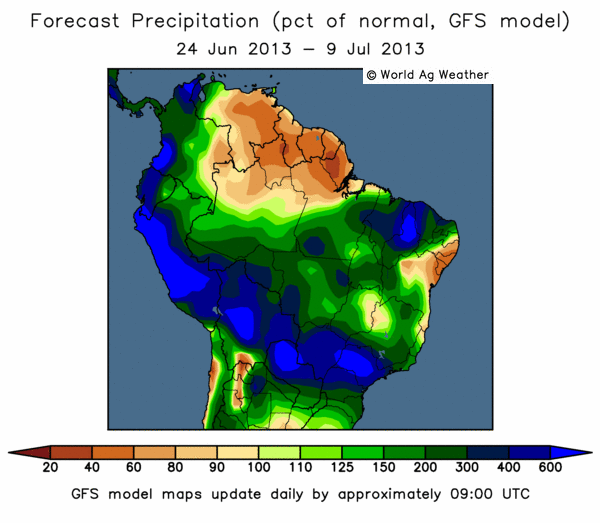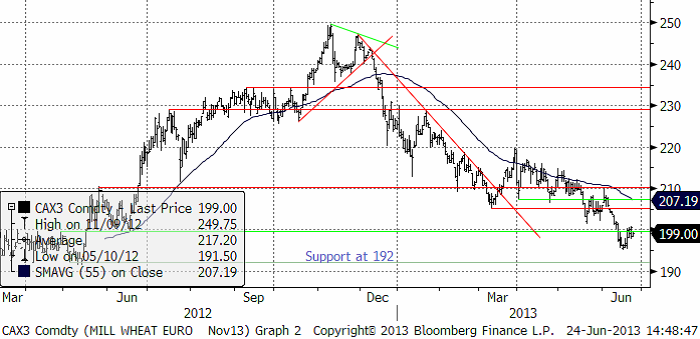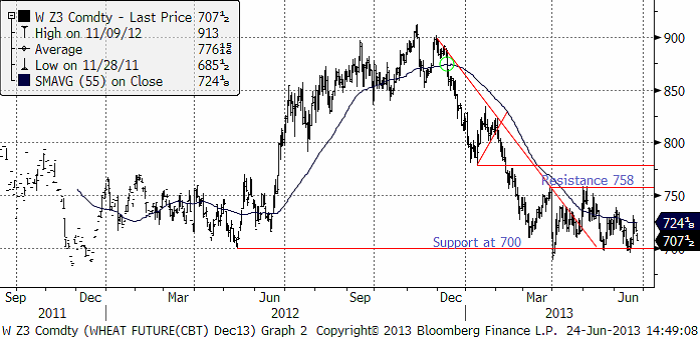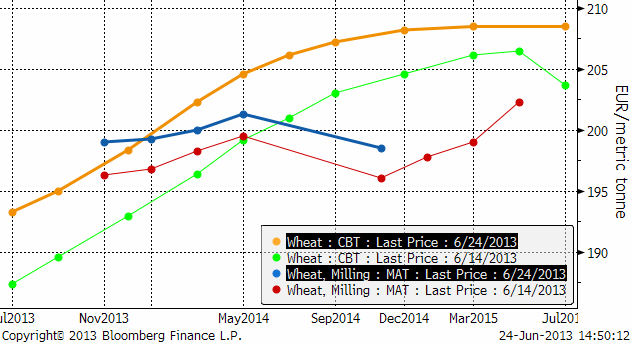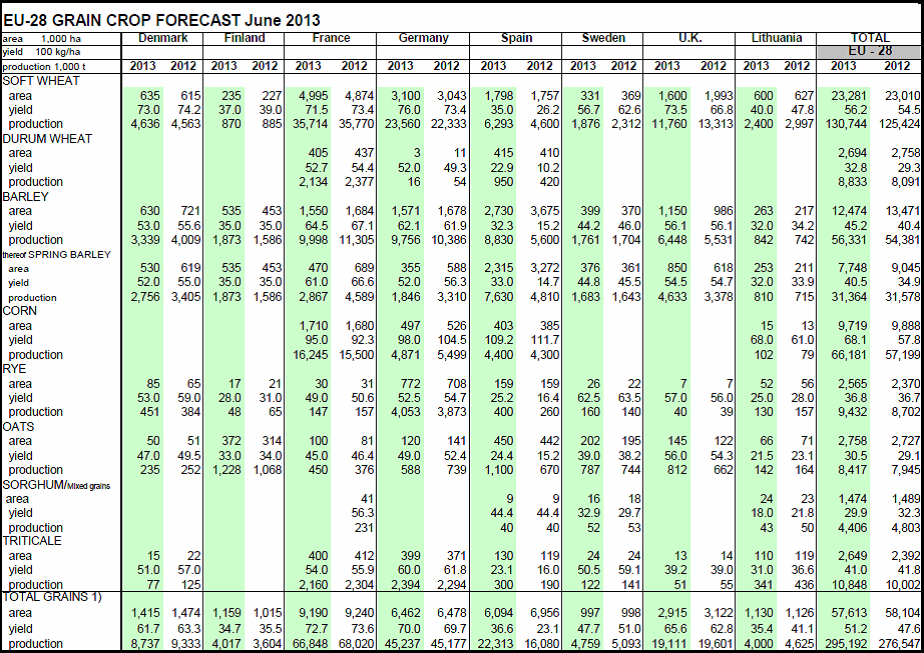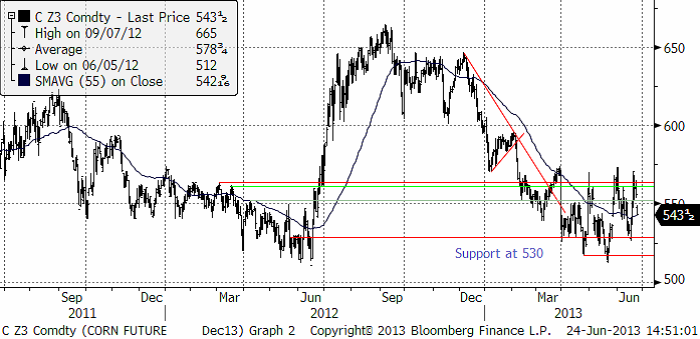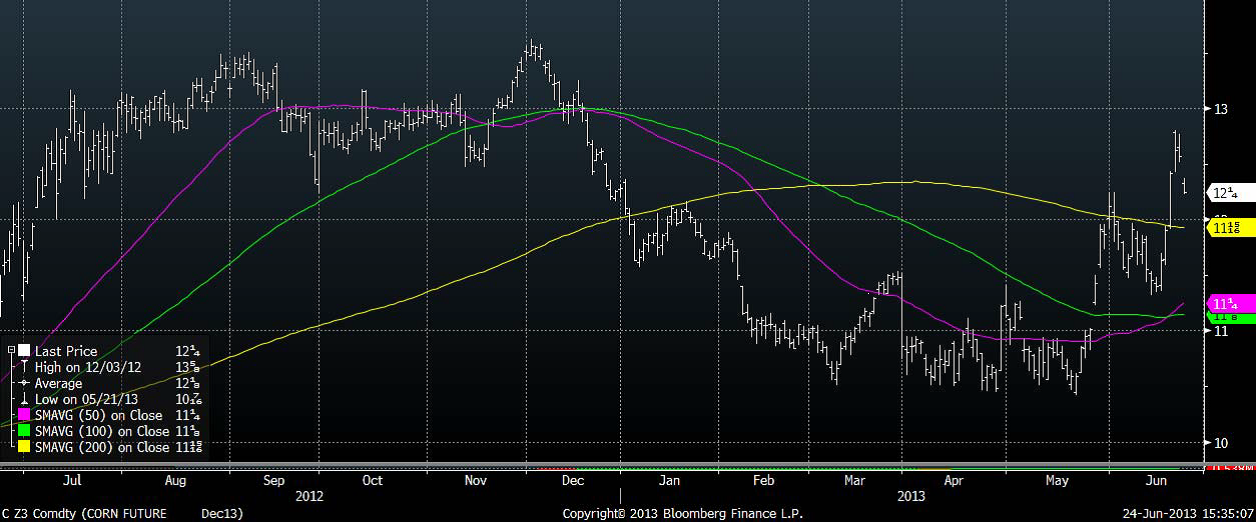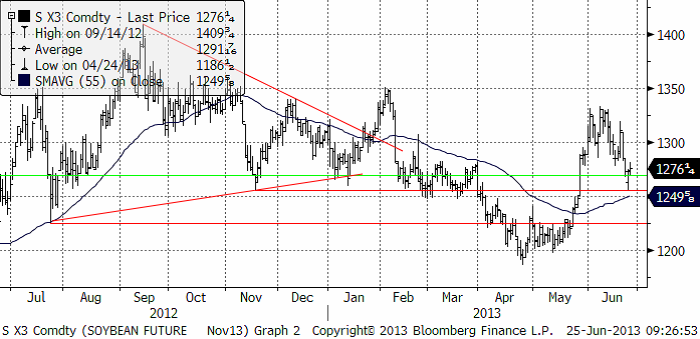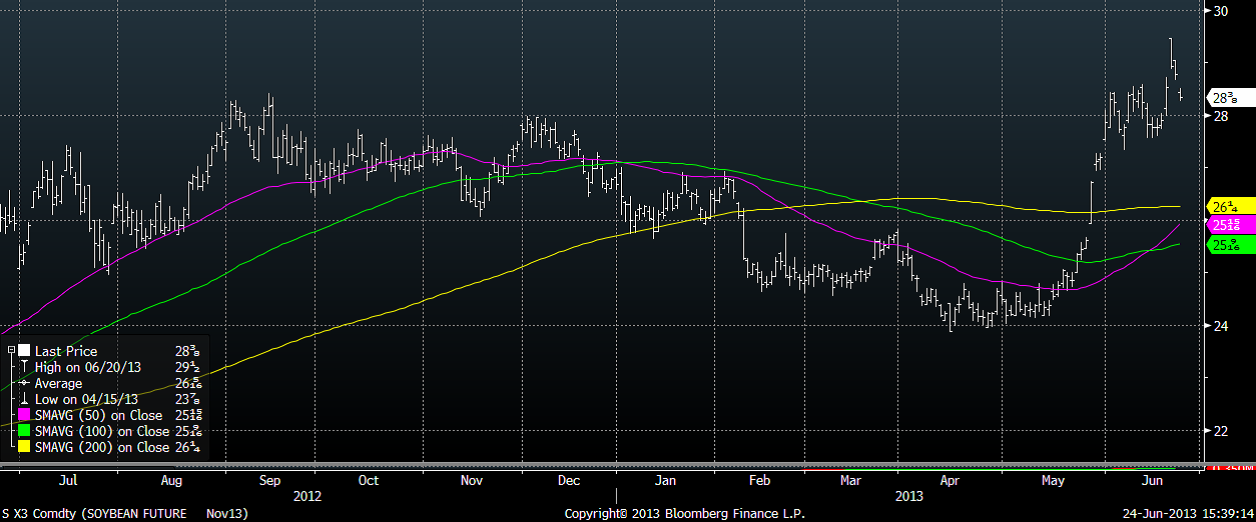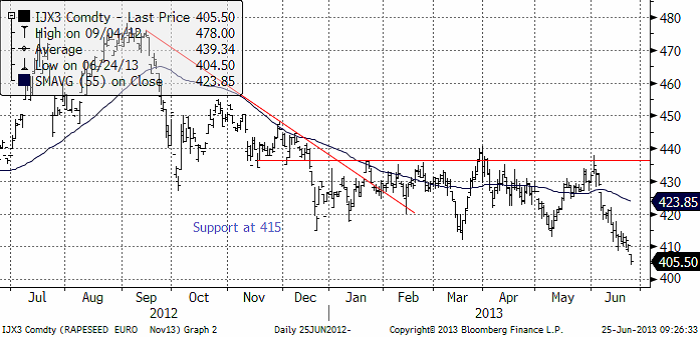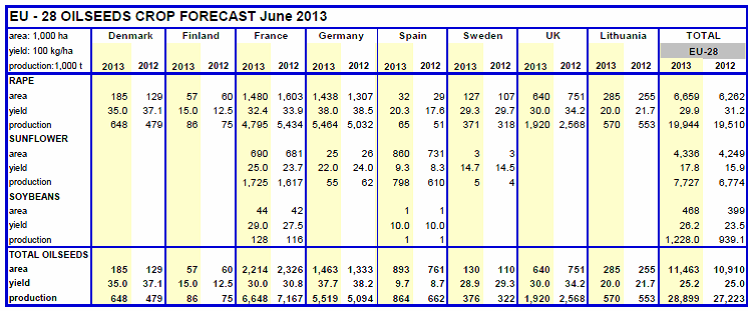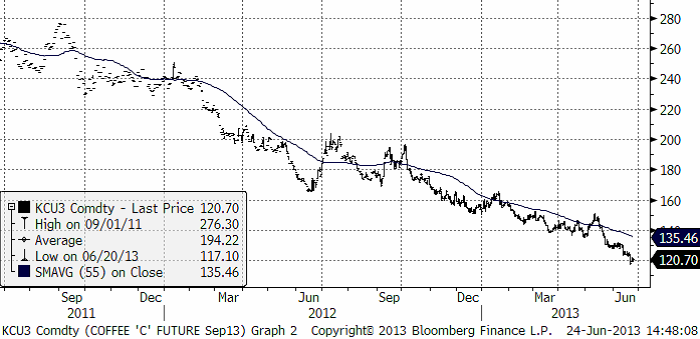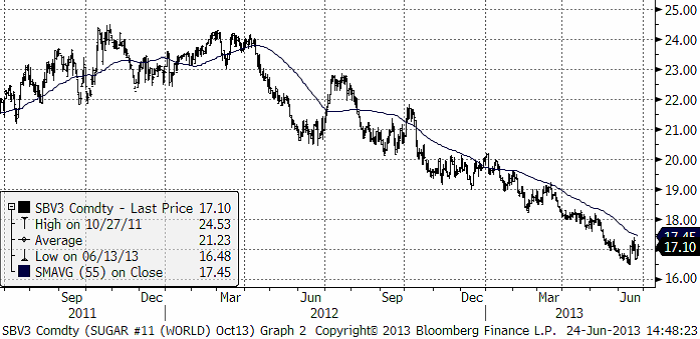Analys
SEB Jordbruksprodukter, 25 juni 2013
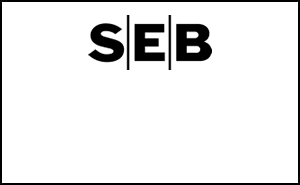
 Odlingsväder
Odlingsväder
GFS-modellens prognos för de kommande två veckorna visar på ordentlig nederbörd längs väst- och östkusterna i USA och i södra Kanada. GFS-modellen (Global Forecast System) används av de amerikanska vädercentralerna för att göra globala väderleksprognoser. Kalifornien har varit torrt i ungefär tio år, men får nu ordentligt med nederbörd. Däremot fortsätter klassiska vete-områden i USA att vara torrare än normalt.
Som vi ser i nedanstående uppdaterade diagram över hur många procent av USA som är drabbat av torka, ser vi att andelen visserligen fallit snabbt, men att det allt jämt är mycket torrare än normalt.
Nedan ser vi en prognoskarta för norra Sydamerika. Vi ser att det nederbördsmönster Brasilien haft tidigare väntas fortsätta. São Paulo-staten får dock nu upp till sex gånger den normala nederbörden. I SP odlas nuförtiden mest sockerrör, då kaffet trängts undan.
Argentina fortsätter dock att få 60-80% av normal nederbörd.
Indiens monsun har börjat rekordtidigt och täcker hela landet med nederbörd.
Vete
Nyheten att Kina köpt 200 kt vete från Frankrike fick prisfallet på Matifs novembertermin att stanna upp. GASC meddelade att de kommer att bjuda in till en tender före 30 juni. De har varit borta från marknaden sedan i februari. Vi betraktar rekylen upp mot 200 euro som just en rekyl mot trenden och att prisfallet fortsätter.
Decemberkontraktet på CBOT har funnit stöd på 700 cent och priset har inte velat gå under den nivån.
Nedan ser vi förändringen i terminskurvorna från fredagen för drygt en vecka sedan, till måndag.
Vädret i Europa är huvudsakligen gynnsamt för produktionen av vete.
Coceral, den europeiska branschföreningen för spannmåls- och oljeväxthandlare, justerar upp sitt estimat för EU-28:s veteproduktion 2013/14 till 130.7 mt, vilket är en ökning från den tidigare prognosen i mars på 127.8 mt och från förra årets 125.4 mt. Revideringen kommer från såväl ökad areal som ökad avkastning. Även estimatet för EU-28:s produktion av korn förväntas öka, trots lägre areal än förra året men på indikationer att avkastningen återhämtar sig i år. Den totala produktionen av korn förväntas uppgå till 56.3 mt, en ökning från det tidigare estimatet på 54.8 mt och förra årets 54.4 mt. Produktionen av majs förväntas uppgå till 66.2 mt, en ökning med 9 mt jämfört med förra året.
EU Kommissionens MARS-enhet gjorde även de en marginell justering uppåt i sin senaste rapport gällande den genomsnittliga avkastningen för vete. För majs och korn gjordes också justeringar uppåt medan avkastningen för raps justeras marginellt nedåt. Rapporteringsperioden har präglats av skarpa väderkontraster i hela Europa, där nederbörd och kalla temperaturer har hämmat grödornas utveckling stora delar av Centraleuropa. Däremot har väderförhållandena varit gynnsamma i Rumänien, Ungern och framförallt i Spanien där en utmärkt säsong ökar estimatet för avkastningen av vårkorn i EU-27. Mest utmärkande för perioden har dock varit de skyfall i Centraleuropa, som ledde till stora översvämningar i närheten av floder och ökad markfuktighet till kritiska nivåer, vilket ökar risken för skadedjur och begränsar grödornas utveckling.
Prognosen för hektarskörden avseende vete inom EU-27 lämnades i stort sett oförändrad på 5.55 t/ha från förra månadens 5.54 t/ha, vilket fortfarande är en ökning med 2.3% jämfört med förra året men strax under det femåriga genomsnittet på 5.63 t/ha. Detta som en följd av en betydande uppjustering av hektarskörden i Spanien, Rumänien och Ungern, som kompenserar för nedjusteringar i Tyskland, Slovakien och Tjeckien. Estimatet för Storbritannien fortsätter att justeras ner, den här gången från 7.68 t/ha till 7.63 t/ha. Grödorna har blivit hårt drabbade av förra årets rekordregn, som inte bara påverkade förra årets skörd utan även sådden av årets grödor.
Rapporten från USDA på fredag handlar mest om majs och sojabönor. Vetemarknaden kommer dock att ta intryck av situationen för majs.
Majs
Majspriset (december 2013) har liksom vetet på Chicago funnit stöd på förra årets bottennivåer med 530 cent som den huvudsakliga bottennivån. Marknaden har visat en tendens att försöka stiga de senaste månaderna. Vi har noterat högre toppar och lägre bottnar i de senaste månadernas handel. Helhetsbilden ser dock ut som en rekyl efter den stora prisnedgången från 650 cent / bu. Om det handlar om det, kan nästa prisrörelse bli nedåt, mot 400 cent.
EU-Kommissionens MARS-enhet reviderade i sin senaste rapport upp hektarskörden avseende majs inom EU-27, från förra månadens 6.87 t/ha till 7.13 t/ha. På årsbasis är det en ökning med 16.3% i förhållande till förra årets 6.13. Det är även högre än det femåriga genomsnittet på 7.01 t/ha. Förklaringen är de väsentligt förbättrade utsikterna för Rumänien och Ungern. Sådden av majs i norra Italien blev kraftigt försenad och låga temperaturer i kombination med kraftig nederbörd gav grödorna en dålig start på säsongen. Väderförhållandena under den kommande månaden kommer att vara avgörande för avkastningen.
Brasilianska Safras prognosticerar att Brasiliens majsskörd hamnar på 82.7 mt. USDA estimerade i den senaste WASDE-rapporten en skörd på 77 mt (en höjning från 76 mt i maj-rapporten). USDA estimerar också att skörden i Brasilien nästa år (2013/14) blir 72 mt. Efter det fall i den brasilianska valutan de senaste månaderna finns dock anledning att tro att produktionen kan bli större än 72 mt, eftersom priset i Brasilien automatiskt har stigit med valutans fall. Se nedanstående diagram, som visar decemberkontraktet på CME uttryckt i BRL / bushel.
Slutsatsen är att vi behåller vår säljrekommendation på majs.
Sojabönor
Priset på novemberkontraktet på sojabönor har rekylerat ner till stödet på 1250 cent. Teknisk analys säger egentligen ”köp”. Nästan all fundamental information säger sälj. Vi har övervägt om vi skulle gå över till åtminstone ”neutral” rekommendation, men väljer på grund av följande faktorer att behålla säljrekommendationen: 1. USDA förutspår väsentligt högre lager, 2. Brasiliens valuta har fallit kraftigt vilket torde öka produktionen i landet, 3. Kinas ekonomi bromsar in ännu mer enligt PMI. 4. Stigande obligationsräntor efter FED:s besked om ett slut på QE dämpar konsumtionen av dyrare mat.
Sådden av sojabönor hade i måndags förra veckan nått till 85% färdigt. Det ska jämföras med 98% samma vecka förra året och 91% som femårigt medelvärde. Däremot är sojabönorna i utmärkt skick. 64% är i good eller excellent kondition. Samma tid förra året var 56% i samma klass.
På fredag publicerar USDA statistik på sådd areal och lager. Det spekuleras i att den sena sådden har minskat arealen, men den sena sådden kan också ha minskat majsarealen och ökat sojaarealen. Marknaden förväntar sig faktiskt att sojaarealen har ökat. Den förväntar sig också att exportsiffrorna har varit för höga och att lagren därmed är större än man tidigare trott. Detta skulle kunna få priset att falla ner mot 10 dollar per bushel, resonerar man.
Den brasilianska valutans fall får liksom för majs, förmodligen konsekvenser för produktionen. Ett högre pris leder till högre produktion, allt annat lika. Nedan ser vi priset på sojabönor (november kontraktet) omräknat till brasilianska reais (BRL):
Det är som vi ser ett pris som är högre än förra året, som stimulerade till en produktion av 82 mt. USDA förväntar sig i den senaste WASDE-rapporten att produktionen i vinter (2013/14) stiger till 85 mt, men det kan faktiskt bli ännu mer, eftersom priset har stigit så kraftigt den senaste månaden.
Vi väljer alltså att ligga kvar med ”sälj” rekommendation på sojabönor.
Raps
Rapspriset (November 2013) bröt genom stödet som hållit i ett halvår. När ett så ihärdigt stöd bryts är det alltid viktigt. Om inget ”bullish” kommer ur fredagens rapport om areal och lager för sojabönor på fredag, bör vi kunna se rapspriset testa och kanske falla under 400 euro per ton.
COCERAL justerar i sin senaste rapport i juni upp väntad produktion av oljeväxter marginellt från estimatet man gjorde i mars om 28.85 mt till 28.89 mt. I denna siffra så har den förväntade produktionen av raps nu glidit under 20 mt-strecket och förväntas uppgå till 19.9 mt – ner från mars månads prognos på 20.1 mt men fortfarande högre än förra årets 19.5 mt.
EU-Kommissionens MARS-enhet justerade i sin juni-rapport ner hektarskörden för raps och rybs 3.06 t/ha till 3.02 t/ha. Den bedöms för närvarande att bli lägre än förra året. Utsikterna för EU:s tre största producentländer Tyskland, Frankrike och Polen har försämrats. Om prognosen besannas blir det här året i så fall det fjärde året i rad för Frankrike med medioker avkastning. Även för mindre producenter som Bulgarien, Slovakien och Tjeckien görs betydande nedjusteringar (med mer än 5%).
Kaffe
Kaffepriset har fallit ytterligare och har nu uppnått den storlek på prisfall som en nedgångsfas i kaffe brukar uppnå (-60%).
Skörden av robusta i nordöstra Brasilien väntas bli mindre och av sämre kvalitet än normalt. Bönorna är både mindre än normalt och mörkare än normalt. Detta beror på att området har varit ovanligt torrt. CEPEA rapporterar att lagren är i stort sett tömda från förra året. Ett positivt tecken, trots allt.
Socker
Priset på socker som tvärvände uppåt för en dryg vecka sedan, föll tillbaka, men inte hela vägen ner. Därefter har priset faktiskt vänt uppåt igen. Detta är en mikrorörelse i förhållande till det stora prisfallet som har pågått i över två år, men eftersom det sker på en så låg nivå att en botten kan vara nära, är det värt att hålla ett öga på utvecklingen framöver. Vi fortsätter tills vidare med neutral rekommendation. En uppgång till 18 cent skulle nog göra att vi bytte till köprekommendation.
[box]SEB Veckobrev Jordbruksprodukter är producerat av SEB Merchant Banking och publiceras i samarbete och med tillstånd på Råvarumarknaden.se[/box]
Disclaimer
The information in this document has been compiled by SEB Merchant Banking, a division within Skandinaviska Enskilda Banken AB (publ) (“SEB”).
Opinions contained in this report represent the bank’s present opinion only and are subject to change without notice. All information contained in this report has been compiled in good faith from sources believed to be reliable. However, no representation or warranty, expressed or implied, is made with respect to the completeness or accuracy of its contents and the information is not to be relied upon as authoritative. Anyone considering taking actions based upon the content of this document is urged to base his or her investment decisions upon such investigations as he or she deems necessary. This document is being provided as information only, and no specific actions are being solicited as a result of it; to the extent permitted by law, no liability whatsoever is accepted for any direct or consequential loss arising from use of this document or its contents.
About SEB
SEB is a public company incorporated in Stockholm, Sweden, with limited liability. It is a participant at major Nordic and other European Regulated Markets and Multilateral Trading Facilities (as well as some non-European equivalent markets) for trading in financial instruments, such as markets operated by NASDAQ OMX, NYSE Euronext, London Stock Exchange, Deutsche Börse, Swiss Exchanges, Turquoise and Chi-X. SEB is authorized and regulated by Finansinspektionen in Sweden; it is authorized and subject to limited regulation by the Financial Services Authority for the conduct of designated investment business in the UK, and is subject to the provisions of relevant regulators in all other jurisdictions where SEB conducts operations. SEB Merchant Banking. All rights reserved.
Analys
More weakness and lower price levels ahead, but the world won’t drown in oil in 2026

Some rebound but not much. Brent crude rebounded 1.5% yesterday to $65.47/b. This morning it is inching 0.2% up to $65.6/b. The lowest close last week was on Thursday at $64.11/b.

The curve structure is almost as week as it was before the weekend. The rebound we now have gotten post the message from OPEC+ over the weekend is to a large degree a rebound along the curve rather than much strengthening at the front-end of the curve. That part of the curve structure is almost as weak as it was last Thursday.
We are still on a weakening path. The message from OPEC+ over the weekend was we are still on a weakening path with rising supply from the group. It is just not as rapidly weakening as was feared ahead of the weekend when a quota hike of 500 kb/d/mth for November was discussed.
The Brent curve is on its way to full contango with Brent dipping into the $50ies/b. Thus the ongoing weakening we have had in the crude curve since the start of the year, and especially since early June, will continue until the Brent crude oil forward curve is in full contango along with visibly rising US and OECD oil inventories. The front-month Brent contract will then flip down towards the $60/b-line and below into the $50ies/b.
At what point will OPEC+ turn to cuts? The big question then becomes: When will OPEC+ turn around to make some cuts? At what (price) point will they choose to stabilize the market? Because for sure they will. Higher oil inventories, some more shedding of drilling rigs in US shale and Brent into the 50ies somewhere is probably where the group will step in.
There is nothing we have seen from the group so far which indicates that they will close their eyes, let the world drown in oil and the oil price crash to $40/b or below.
The message from OPEC+ is also about balance and stability. The world won’t drown in oil in 2026. The message from the group as far as we manage to interpret it is twofold: 1) Taking back market share which requires a lower price for non-OPEC+ to back off a bit, and 2) Oil market stability and balance. It is not just about 1. Thus fretting about how we are all going to drown in oil in 2026 is totally off the mark by just focusing on point 1.
When to buy cal 2026? Before Christmas when Brent hits $55/b and before OPEC+ holds its last meeting of the year which is likely to be in early December.
Brent crude oil prices have rebounded a bit along the forward curve. Not much strengthening in the structure of the curve. The front-end backwardation is not much stronger today than on its weakest level so far this year which was on Thursday last week.

The front-end backwardation fell to its weakest level so far this year on Thursday last week. A slight pickup yesterday and today, but still very close to the weakest year to date. More oil from OPEC+ in the coming months and softer demand and rising inventories. We are heading for yet softer levels.

Analys
A sharp weakening at the core of the oil market: The Dubai curve

Down to the lowest since early May. Brent crude has fallen sharply the latest four days. It closed at USD 64.11/b yesterday which is the lowest since early May. It is staging a 1.3% rebound this morning along with gains in both equities and industrial metals with an added touch of support from a softer USD on top.

What stands out the most to us this week is the collapse in the Dubai one to three months time-spread.
Dubai is medium sour crude. OPEC+ is in general medium sour crude production. Asian refineries are predominantly designed to process medium sour crude. So Dubai is the real measure of the balance between OPEC+ holding back or not versus Asian oil demand for consumption and stock building.
A sharp weakening of the front-end of the Dubai curve. The front-end of the Dubai crude curve has been holding out very solidly throughout this summer while the front-end of the Brent and WTI curves have been steadily softening. But the strength in the Dubai curve in our view was carrying the crude oil market in general. A source of strength in the crude oil market. The core of the strength.
The now finally sharp decline of the front-end of the Dubai crude curve is thus a strong shift. Weakness in the Dubai crude marker is weakness in the core of the oil market. The core which has helped to hold the oil market elevated.
Facts supports the weakening. Add in facts of Iraq lifting production from Kurdistan through Turkey. Saudi Arabia lifting production to 10 mb/d in September (normal production level) and lifting exports as well as domestic demand for oil for power for air con is fading along with summer heat. Add also in counter seasonal rise in US crude and product stocks last week. US oil stocks usually decline by 1.3 mb/week this time of year. Last week they instead rose 6.4 mb/week (+7.2 mb if including SPR). Total US commercial oil stocks are now only 2.1 mb below the 2015-19 seasonal average. US oil stocks normally decline from now to Christmas. If they instead continue to rise, then it will be strongly counter seasonal rise and will create a very strong bearish pressure on oil prices.
Will OPEC+ lift its voluntary quotas by zero, 137 kb/d, 500 kb/d or 1.5 mb/d? On Sunday of course OPEC+ will decide on how much to unwind of the remaining 1.5 mb/d of voluntary quotas for November. Will it be 137 kb/d yet again as for October? Will it be 500 kb/d as was talked about earlier this week? Or will it be a full unwind in one go of 1.5 mb/d? We think most likely now it will be at least 500 kb/d and possibly a full unwind. We discussed this in a not earlier this week: ”500 kb/d of voluntary quotas in October. But a full unwind of 1.5 mb/d”
The strength in the front-end of the Dubai curve held out through summer while Brent and WTI curve structures weakened steadily. That core strength helped to keep flat crude oil prices elevated close to the 70-line. Now also the Dubai curve has given in.

Brent crude oil forward curves

Total US commercial stocks now close to normal. Counter seasonal rise last week. Rest of year?

Total US crude and product stocks on a steady trend higher.

Analys
OPEC+ will likely unwind 500 kb/d of voluntary quotas in October. But a full unwind of 1.5 mb/d in one go could be in the cards

Down to mid-60ies as Iraq lifts production while Saudi may be tired of voluntary cut frugality. The Brent December contract dropped 1.6% yesterday to USD 66.03/b. This morning it is down another 0.3% to USD 65.8/b. The drop in the price came on the back of the combined news that Iraq has resumed 190 kb/d of production in Kurdistan with exports through Turkey while OPEC+ delegates send signals that the group will unwind the remaining 1.65 mb/d (less the 137 kb/d in October) of voluntary cuts at a pace of 500 kb/d per month pace.

Signals of accelerated unwind and Iraqi increase may be connected. Russia, Kazakhstan and Iraq were main offenders versus the voluntary quotas they had agreed to follow. Russia had a production ’debt’ (cumulative overproduction versus quota) of close to 90 mb in March this year while Kazakhstan had a ’debt’ of about 60 mb and the same for Iraq. This apparently made Saudi Arabia angry this spring. Why should Saudi Arabia hold back if the other voluntary cutters were just freeriding? Thus the sudden rapid unwinding of voluntary cuts. That is at least one angle of explanations for the accelerated unwinding.
If the offenders with production debts then refrained from lifting production as the voluntary cuts were rapidly unwinded, then they could ’pay back’ their ’debts’ as they would under-produce versus the new and steadily higher quotas.
Forget about Kazakhstan. Its production was just too far above the quotas with no hope that the country would hold back production due to cross-ownership of oil assets by international oil companies. But Russia and Iraq should be able to do it.
Iraqi cumulative overproduction versus quotas could reach 85-90 mb in October. Iraq has however steadily continued to overproduce by 3-5 mb per month. In July its new and gradually higher quota came close to equal with a cumulative overproduction of only 0.6 mb that month. In August again however its production had an overshoot of 100 kb/d or 3.1 mb for the month. Its cumulative production debt had then risen to close to 80 mb. We don’t know for September yet. But looking at October we now know that its production will likely average close to 4.5 mb/d due to the revival of 190 kb/d of production in Kurdistan. Its quota however will only be 4.24 mb/d. Its overproduction in October will thus likely be around 250 kb/d above its quota with its production debt rising another 7-8 mb to a total of close to 90 mb.
Again, why should Saudi Arabia be frugal while Iraq is freeriding. Better to get rid of the voluntary quotas as quickly as possible and then start all over with clean sheets.
Unwinding the remaining 1.513 mb/d in one go in October? If OPEC+ unwinds the remaining 1.513 mb/d of voluntary cuts in one big go in October, then Iraq’s quota will be around 4.4 mb/d for October versus its likely production of close to 4.5 mb/d for the coming month..
OPEC+ should thus unwind the remaining 1.513 mb/d (1.65 – 0.137 mb/d) in one go for October in order for the quota of Iraq to be able to keep track with Iraq’s actual production increase.
October 5 will show how it plays out. But a quota unwind of at least 500 kb/d for Oct seems likely. An overall increase of at least 500 kb/d in the voluntary quota for October looks likely. But it could be the whole 1.513 mb/d in one go. If the increase in the quota is ’only’ 500 kb/d then Iraqi cumulative production will still rise by 5.7 mb to a total of 85 mb in October.
Iraqi production debt versus quotas will likely rise by 5.7 mb in October if OPEC+ only lifts the overall quota by 500 kb/d in October. Here assuming historical production debt did not rise in September. That Iraq lifts its production by 190 kb/d in October to 4.47 mb/d (August level + 190 kb/d) and that OPEC+ unwinds 500 kb/d of the remining quotas in October when they decide on this on 5 October.

-

 Nyheter4 veckor sedan
Nyheter4 veckor sedanMahvie Minerals i en guldtrend
-

 Analys4 veckor sedan
Analys4 veckor sedanVolatile but going nowhere. Brent crude circles USD 66 as market weighs surplus vs risk
-

 Nyheter4 veckor sedan
Nyheter4 veckor sedanAktier i guldbolag laggar priset på guld
-

 Nyheter3 veckor sedan
Nyheter3 veckor sedanKinas elproduktion slog nytt rekord i augusti, vilket även kolkraft gjorde
-

 Nyheter3 veckor sedan
Nyheter3 veckor sedanTyskland har så höga elpriser att företag inte har råd att använda elektricitet
-

 Nyheter4 veckor sedan
Nyheter4 veckor sedanGuld når sin högsta nivå någonsin, nu även justerat för inflation
-

 Nyheter3 veckor sedan
Nyheter3 veckor sedanDet stigande guldpriset en utmaning för smyckesköpare
-

 Analys4 veckor sedan
Analys4 veckor sedanWaiting for the surplus while we worry about Israel and Qatar


